Our trinocular port adapters are compatible with all major microscope brands including Zeiss, Nikon, Olympus, Leica, Motic, and AmScope. You’ll need to select the correct brand-specific adapter to avoid vignetting and guarantee parfocality between your camera and eyepieces. Using the proper adapter with appropriate magnification factor (typically 0.3x to 0.7x) is essential for ideal image quality. The following sections will help you identify the exact adapter for your setup.
Numeric List of Second-Level Headings
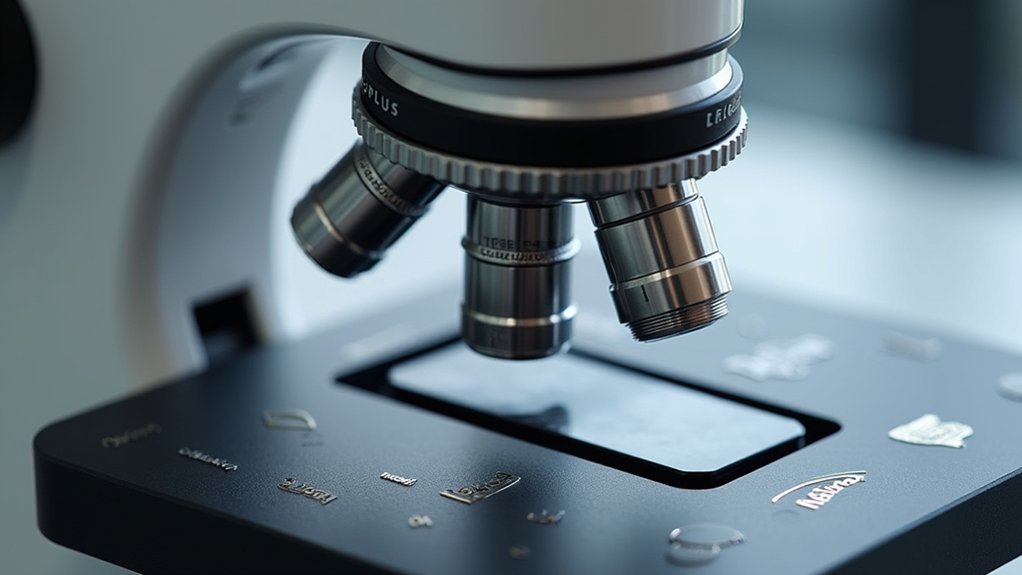
When selecting trinocular port adapters, you’ll encounter several important considerations that determine compatibility and performance. The most essential factor is brand compatibility—your adapter must match your microscope manufacturer (Zeiss, Nikon, Olympus, Leica, or Motic microscope).
- Brand-Specific Adapter Requirements
- C-Mount Camera Adapter Specifications
- Camera Chip Size Compatibility
- Preventing Vignetting Issues
- Achieving Parfocal Capability
While all C-Mount adapters feature the standard 1″ (25mm) thread, using a generic adapter with your trinocular port can cause serious imaging problems.
While the universal C-Mount thread may seem convenient, generic trinocular adapters often introduce significant image quality issues that compromise your microscopy work.
For best results, match your camera’s chip size with the appropriate magnification adapter—typically 0.3x for 1/3″ chips and 0.7x for 2/3″ chips. This guarantees your imaging system produces clear, properly magnified images without quality compromises.
Understanding C-Mount Adapter Compatibility Across Microscope Brands
When you’re connecting a camera to your microscope’s trinocular port, you’ll quickly discover that C-Mount adapters aren’t universally compatible across brands.
Zeiss, Olympus, Nikon, and Leica each require their own specific adapter designs to maintain proper parfocality and field of view.
You’ll need to consult a brand compatibility matrix to guarantee your adapter matches both your microscope manufacturer and your camera’s sensor size to avoid vignetting or focus issues.
Brand Compatibility Matrix
The complex world of C-Mount adapter compatibility requires careful navigation when setting up your trinocular microscope system.
Microscope manufacturers like Zeiss, Nikon, Olympus, Leica, and Motic each design their trinocular ports with unique specifications that demand brand-specific C-Mount adapters.
While the 1-inch (25mm) thread diameter remains standard across all C-Mount adapters, their internal designs and optical characteristics vary markedly between brands.
You’ll encounter serious image quality issues—including vignetting and loss of parfocal capability—if you attempt to use a generic adapter with your specialized microscope.
For peak performance, always match your C-Mount adapter to your specific microscope brand and model.
Consult your manufacturer’s guidelines before purchasing adapters to guarantee proper compatibility and to preserve the optical integrity of your imaging system.
Parfocality Across Manufacturers
Parfocality throughout a microscope system represents one of the most significant challenges when integrating cameras across different manufacturer ecosystems. When you attach a microscope camera using a generic adapter rather than a brand-specific C-Mount, you’ll likely compromise simultaneous focus between your eyepieces and camera image.
| Brand | Parfocality Challenge | Recommended Solution |
|---|---|---|
| Olympus | Unique trinocular dimensions | Dedicated Olympus adapter only |
| Leica | Proprietary port design | Brand-specific adapter with correct magnification |
| Nikon | Non-compatible with other brands | Nikon C-Mount with chip-size matching |
| Zeiss | Precise optical path requirements | Zeiss-certified adapters only |
| Motic | Distinct port specifications | Motic adapter matched to camera sensor |
Your camera’s chip size further complicates this equation, as each manufacturer recommends specific magnification factors for their adapters to achieve ideal imaging results without vignetting or resolution loss.
Zeiss Trinocular Ports: Adapter Requirements and Specifications
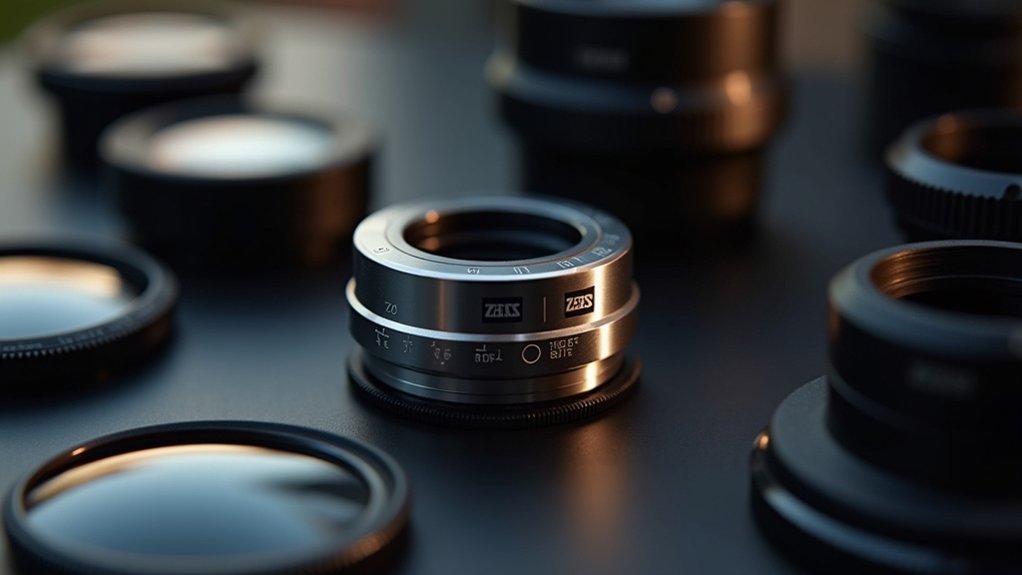
Scientists and microscopists working with Zeiss trinocular microscopes must select appropriate C-mount adapters specifically designed for their model to guarantee compatibility and ideal imaging.
These adapters feature standard 1-inch (25mm) diameter threads that connect directly to the trinocular port.
Standard C-mount adapters provide universal 1-inch (25mm) threads that securely interface with your Zeiss trinocular port for reliable imaging connections.
Don’t attempt to use generic C-mount adapters with your Zeiss microscope. This shortcut often results in parfocality issues and focus misalignment between your camera and eyepieces, compromising your research results.
You’ll need to match your camera’s chip size with the correct adapter magnification—typically 0.45x or 0.6x for standard Zeiss eyepiece configurations.
For best results, consult Zeiss documentation or contact their customer support to identify the precise adapter model required for your specific trinocular setup.
Nikon and Olympus Microscope Compatibility Guide
When selecting a C-mount adapter for your Nikon or Olympus trinocular microscope, you’ll need to match the adapter to both your microscope model and camera sensor size.
Your choice between 0.3x to 0.6x magnification adapters will determine the field of view and resolution achievable with your imaging setup.
To maintain parfocal imaging between your eyepieces and camera, make certain you’re pairing compatible eyepieces with the appropriate C-mount adapter recommended in your manufacturer’s compatibility chart.
Adapter Selection Guide
Selecting the right trinocular port adapter for your Nikon or Olympus microscope requires careful consideration of several key factors. You’ll need to guarantee proper compatibility between your microscope’s trinocular port and your camera system.
| Microscope | Recommended Adapter | Compatible Sensor Size |
|---|---|---|
| Nikon | Nikon C-mount | 1/3″ (0.3x) |
| Nikon | Nikon C-mount Pro | 1/2″ (0.5x) |
| Olympus | Olympus C-mount | 1/3″ (0.3x) |
| Olympus | Olympus C-mount HD | 1/2″ (0.5x) |
| Either | Generic (not ideal) | Varies |
Always verify your specific microscope model before purchasing an adapter. While both brands use standard 1″ (25mm) diameter threads, they’re not interchangeable. Using brand-specific adapters guarantees parfocality between your eyepieces and camera, delivering superior imaging results that generic adapters can’t match.
Camera Mounting Options
Properly mounting your camera to a Nikon or Olympus microscope requires the right adapter to guarantee excellent imaging results.
For Nikon systems, you’ll need their specific C-Mount adapters designed for trinocular ports to guarantee proper alignment and focus with your eyepieces.
Olympus microscopes demand their dedicated adapters, such as the U-TVO.5XC model, which provides ideal compatibility with their trinocular setups.
Both manufacturers design their adapters to accommodate various camera chip sizes, allowing you to select based on your sensor dimensions.
Don’t compromise with generic adapters—they often fail to deliver the parfocal capability needed for simultaneous focus between camera and eyepiece.
Always verify that your C-Mount adapter matches your microscope’s trinocular port specifications to avoid vignetting or misalignment issues during your imaging work.
Parfocal Imaging Solutions
Achieving true parfocal imaging with Nikon and Olympus microscopes requires specialized adapters that maintain focus consistency between eyepieces and camera.
These premium microscope brands demand precise C-Mount adapters specifically engineered for their trinocular ports.
For your Nikon system, look for adapters with appropriate magnification ratios (typically 0.5x or 0.3x) that match your camera’s sensor size.
This guarantees ideal field of view without vignetting.
Olympus microscopes similarly need brand-specific adapters that preserve the parfocal relationship.
When selecting your adapter, you’ll need to verify compatibility with your exact model number.
Don’t compromise on adapter quality—the right choice guarantees that what you see through your eyepieces perfectly matches what your camera captures, maintaining consistent focus across all viewing options.
Leica Microscope Systems: Finding the Right Adapter
When pairing your camera with a Leica microscope, the specific C-mount adapter you choose can make or break your imaging results. For Leica systems, you’ll need adapters specifically designed for their trinocular ports—generic options simply won’t deliver ideal performance.
First identify your microscope model (DM or M series), then match the adapter to both your camera specifications and microscope requirements.
- A properly aligned adapter revealing crisp, edge-to-edge detail of cellular structures
- Reduction lenses in the adapter seamlessly matching eyepiece and camera magnifications
- Your camera sensor capturing the full field of view without dark corners or vignetting
- Perfect parfocality between what you see through eyepieces and what appears on screen
- Precision-machined threading creating a secure, wobble-free connection to your camera
Matching Camera Sensor Size to C-Mount Reduction Factors
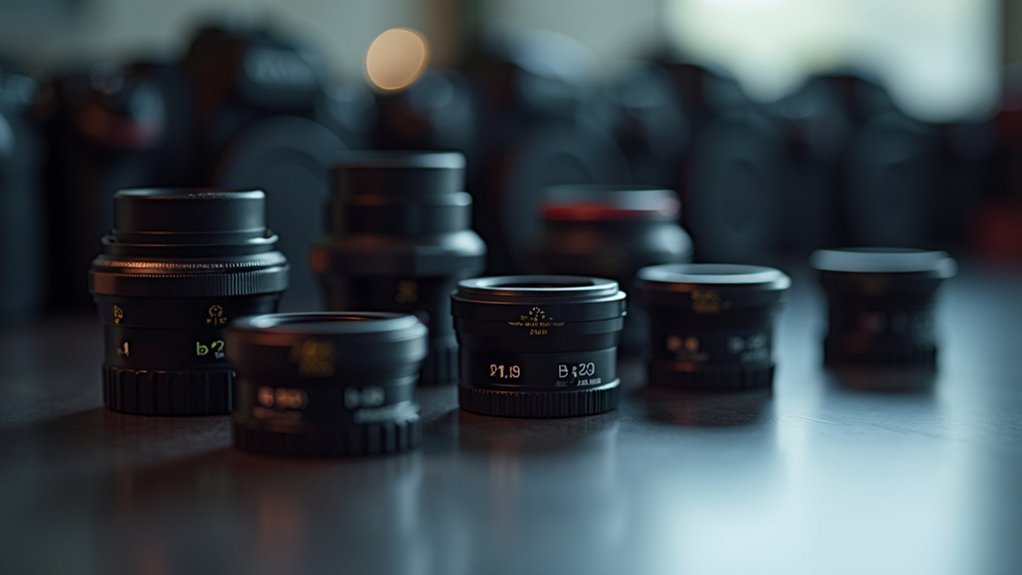
The perfect marriage between your camera’s sensor size and the C-mount adapter’s reduction factor forms the cornerstone of successful microscopy imaging. This pairing guarantees peak image quality without vignetting or distortion.
For smaller sensors, select appropriate reduction factors: a 1/4″ sensor works best with 0.265x or 0.3x adapters, while 1/3″ sensors require 0.3x adapters.
If you’re using a camera with a 1/2″ sensor, choose adapters in the 0.45x to 0.6x range to maintain clarity and proper field of view.
Larger 1/1.8″ sensors also perform well with 0.45x to 0.6x reduction factors, providing magnification comparable to your eyepieces.
For the substantial 2/3″ chip sensors, you’ll need a 0.7x adapter to guarantee full compatibility with your trinocular system.
AmScope and Motic Trinocular Port Adapter Solutions
Proprietary trinocular port adapters from AmScope and Motic provide tailored solutions for researchers seeking perfect camera integration with their microscopes.
When selecting between these manufacturers, you’ll find purpose-built adapters that guarantee ideal imaging results with their respective systems.
- AmScope’s adapters connect seamlessly with ZM-Series microscopes, creating a direct pathway for Moticam integration.
- Motic’s C-mount adapters feature precision machining that aligns perfectly with their microscope’s optical path.
- Both manufacturers maintain the industry-standard 1″ (25mm) C-mount thread for universal camera compatibility.
- The right adapter eliminates vignetting, creating crisp, full-frame images without darkened corners.
- Matching your microscope model with its dedicated adapter guarantees optical alignment and consistent magnification results.
Always verify compatibility between your camera’s sensor size and the adapter’s reduction factor before purchase.
Common Compatibility Issues With Generic Adapters
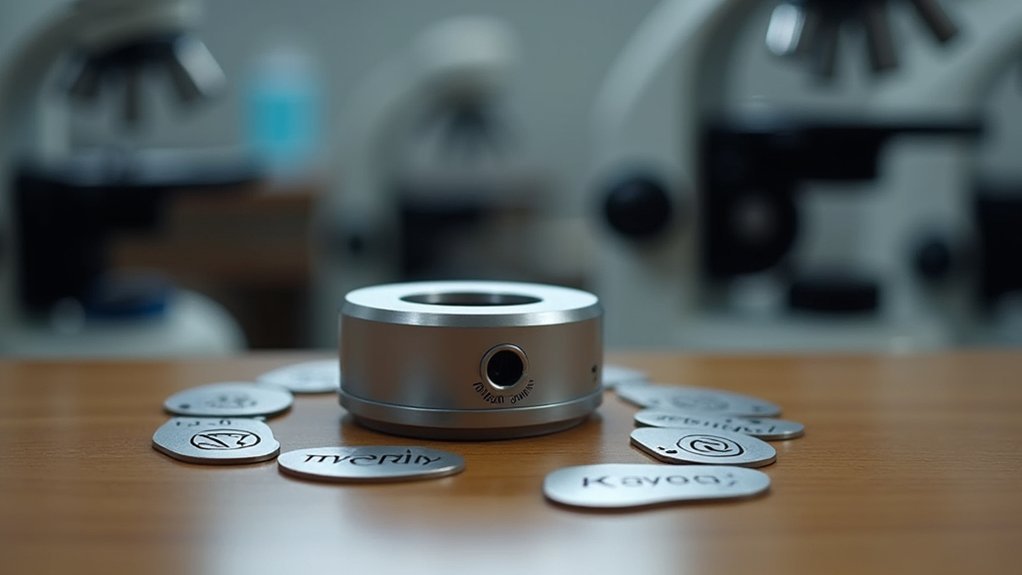
Unlike manufacturer-specific options, generic C-mount adapters often create more problems than they solve in microscopy applications.
You’ll likely experience parfocality issues, where the camera and eyepiece images don’t align properly, making it difficult to capture what you’re seeing.
These generic solutions typically lack the precise threading required for brands like Zeiss or Nikon, resulting in poor fit and functionality.
Generic adapters lack the precision engineering needed for premium microscope brands, compromising both fit and performance.
When used with trinocular ports, they frequently cause vignetting—dark edges around your images—particularly with larger sensors.
Microscopes like Motic require dedicated adapters due to their unique port dimensions.
Without them, you’ll struggle to achieve ideal focus and image quality.
Your research or documentation work will suffer as a result, undermining the investment you’ve made in your microscope setup.
Ergo-Zoom and ProZoom Series Adapter Specifications
The True Trinocular Port Adapter for Ergo-Zoom® series microscopes offers you seamless camera integration while maintaining full access to all eyepieces.
You’ll find it fully compatible with the 6MP Ultra-Cam™ and various magnification ranges throughout the ProZoom® lineup.
Its compact 9 x 4 x 8 inch design guarantees you won’t sacrifice workspace efficiency when upgrading your imaging capabilities.
Subheading Discussion Points
When selecting adapters for microscopy imaging applications, you’ll find that both Ergo-Zoom® and ProZoom® series offer specialized specifications tailored to different needs.
These adapters connect seamlessly to trinocular ports, enabling high-quality imaging without sacrificing eyepiece functionality.
- Standard 1″ (25mm) diameter thread guarantees cross-compatibility with multiple microscope brands
- True Trinocular Port Adapter compatible with 6MP Ultra-Cam™ for crystal-clear imaging
- .3x CCD adapter specifically designed for ProZoom® microscopes enhances imaging versatility
- Ergo-Zoom® adapters connect cameras directly to trinocular ports for streamlined workflow
- Verification of compatibility with specific models (like ZM6745T) guarantees peak performance
Before purchasing, you’ll want to confirm which adapter series works with your existing equipment to achieve the best imaging results for your specific microscopy applications.
Magnification Compatibility Range
Understanding specific magnification ranges helps you select the ideal adapter for your microscope setup.
The Ergo-Zoom® series adapters maintain parfocality between your camera and eyepieces, guaranteeing what you see through the eyepieces is simultaneously in focus with what your camera captures.
ProZoom® adapters offer versatile magnification from 0.3x to 0.75x, accommodating various camera chip sizes while minimizing vignetting.
For best results, match the adapter to your camera’s chip size—use a 0.3x adapter with 1/3″ chips or a 0.45x adapter with 1/2″ chips.
When combined with standard 10x eyepieces, these adapters guarantee your camera captures images at a scale comparable to what you observe visually.
Remember that both Ergo-Zoom® and ProZoom® adapters are designed for specific microscope models, so you’ll need to select accordingly.
Camera Integration Specifications
Seamless camera integration remains a hallmark feature of both the Ergo-Zoom® and ProZoom® series adapters.
The Ergo-Zoom® adapter lets you integrate your camera without sacrificing an eye port, enabling simultaneous viewing and imaging. It’s specifically fine-tuned for the 6MP Ultra-Cam™, delivering superior imaging quality when connected to Ergo-Zoom® microscopes.
For the ProZoom® series, you’ll find a .3x CCD adapter that pairs perfectly with ProZoom® microscopes, enhancing image clarity while reducing vignetting effects.
- C-mount adapters feature standard 1″ (25mm) diameter threads across both series
- Each adapter is precisely matched to specific eyepiece magnifications
- Ergo-Zoom® adapters maintain dual-viewing capability while imaging
- ProZoom® .3x adapters minimize vignetting for cleaner image edges
- Both systems facilitate ideal light transmission for bright, clear images
The Impact of Adapter Selection on Image Quality
Selecting the right C-mount adapter dramatically influences the quality of microscope images you’ll capture. Brand-specific adapters (Zeiss, Nikon) maintain parfocality more effectively than generic options, ensuring your camera and eyepieces focus simultaneously.
The precision of brand-specific C-mount adapters ensures perfect microscope-to-camera alignment that generic options simply cannot match.
The adapter’s magnification factor, determined by its reduction lens, must match your camera’s chip size to avoid vignetting and distortion. When properly matched, you’ll achieve higher resolution images with minimal artifacts. Larger image sensors require adapters specifically designed to accommodate their size without compromising field of view.
For both professional research and educational applications, your adapter choice directly impacts image fidelity.
Don’t underestimate this vital component—the connection between microscope and camera fundamentally determines whether subtle details appear crisp and clear or become lost in poor adaptation.
Frequently Asked Questions
What Is a Trinocular Port?
A trinocular port is a specialized microscope feature that lets you view specimens through eyepieces while simultaneously connecting a camera. It splits light between your eyes and the imaging device for concurrent observation and documentation.
What Is a C-Mount Adapter?
A C-mount adapter connects your microscope camera to the trinocular port. It has a standard 25mm thread and often includes reduction lenses to guarantee your camera captures the same magnified image you see through eyepieces.
What Size Is the C-Mount on a Microscope?
The standard C-mount on microscopes is 1 inch (25.4 mm) in diameter. You’ll need to guarantee your adapter matches this size for proper fit and to avoid issues like vignetting in your images.
What Is a Microscope Adapter?
A microscope adapter is a device you’ll use to connect your camera to a microscope’s trinocular port. It guarantees you’re capturing clear images while maintaining proper focus between your camera and eyepieces.
In Summary
You’ll find our trinocular port adapters work with most major microscope brands including Zeiss, Nikon, Olympus, Leica, AmScope, and Motic. Select the correct C-mount adapter for your specific model to guarantee proper fit and ideal image quality. Don’t settle for generic adapters that might cause alignment issues. Check our compatibility charts or contact our technical team if you’re unsure which adapter matches your microscope’s exact specifications.

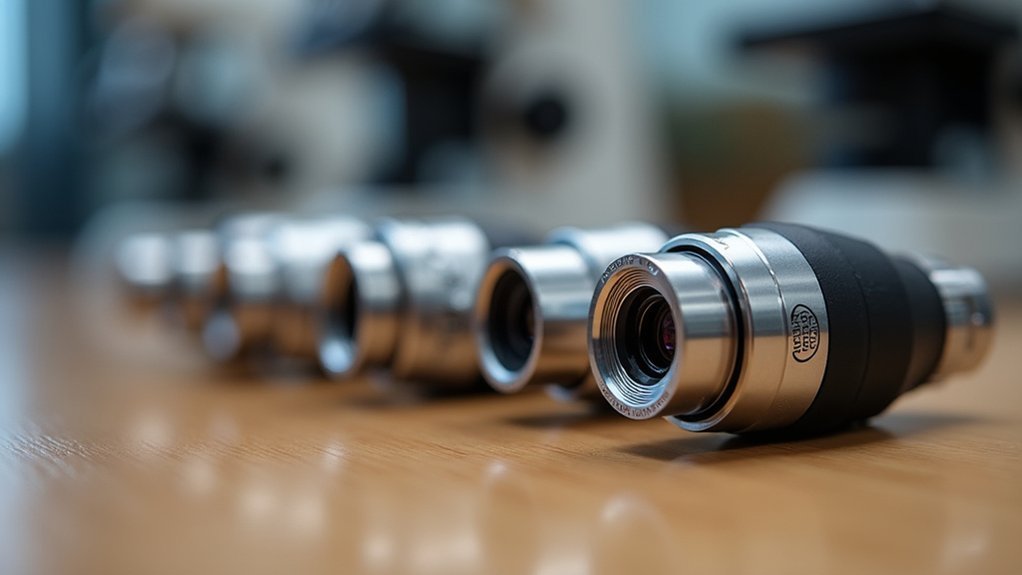



Leave a Reply